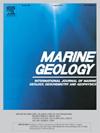Storm-Driven Tree Exposure and Geomorphic Change: Predicting the Distribution of Preserved Late Pleistocene Tree Stumps on the Outer Alabama Continental Shelf
IF 2.6
3区 地球科学
Q2 GEOSCIENCES, MULTIDISCIPLINARY
引用次数: 0
Abstract
The Alabama Underwater or Drowned Forest is a well-preserved Late Pleistocene (dated to 72–56 ± 8 ka, 2σ) terrestrial landform on the northern Gulf of Mexico continental shelf that provides geomorphic and ecosystem information rarely preserved during the glacial intervals. Stumps of bald cypress (Taxodium distichum (L.) Rich.) trees were exposed in ∼18 m of water following Hurricane Ivan in 2004. This research investigates geomorphic changes to the Mississippi-Alabama-Florida (MAFLA) sand sheet, which presents as shore-oblique Holocene sand ridges, and the exposure and burial of tree stumps following the passage of Hurricane Sally in 2020 using repeat sidescan and bathymetric surveys (2015–2016 and 2021). Using two newly identified tree exposure areas and their geological properties, this research also hypothesized a new location where tree stumps may be outcropping. The bathymetry indicates regions with up to ∼1 m of erosion and deposition over the five years between the two surveys. Similarly, the sidescan sonar indicates changes in the location and numbers of exposed tree stumps as well as between 47,000 and 62,500 tons of sediment erosion within the study area following Hurricane Sally. The 2015 and 2016 data found 25 tree contacts whereas the 2021 survey found 76 tree contacts and only 5 of them occurred in both surveys suggesting the tree exposures are dynamic and presumably changing with the passing of large tropical cyclones. Additionally, the hypothesized exposure location had 26 newly identified tree stump contacts within a mixed texture unit along the sand-mud boundary, confirming our understanding of the geomorphic characteristics leading to the exposure of the buried forest. This research will expand the potential areas for investigations into Late Pleistocene ecosystems and landforms and their associated climatic and ecologic conditions in the Gulf of Mexico as well as in other passive continental margins.
风暴驱动的树木暴露和地貌变化:预测阿拉巴马州外大陆架保存的晚更新世树桩的分布情况
阿拉巴马水下森林或淹没森林是墨西哥湾北部大陆架上保存完好的晚更新世(年代为 72-56 ± 8 ka,2σ)陆地地貌,它提供了冰川期很少保存的地貌和生态系统信息。2004 年伊万飓风过后,秃柏(Taxodium distichum (L.) Rich.)树桩暴露在水下 18 米处。本研究利用重复侧向扫描和水深测量调查(2015-2016 年和 2021 年),调查了密西西比-阿拉巴马-佛罗里达(MAFLA)沙层的地貌变化(表现为海岸斜向全新世沙脊),以及 2020 年飓风莎莉过后树桩的暴露和掩埋情况。利用新发现的两个树木暴露区及其地质特性,该研究还假设了一个树桩可能出露的新地点。水深测量结果表明,在两次勘测之间的五年里,该区域的侵蚀和沉积达 1 米。同样,侧扫声纳显示,在飓风莎莉过后,研究区域内暴露树桩的位置和数量发生了变化,沉积物侵蚀量在 4.7 万吨至 6.25 万吨之间。2015 年和 2016 年的数据发现有 25 处树木接触点,而 2021 年的调查发现有 76 处树木接触点,其中只有 5 处在两次调查中都出现了,这表明树木暴露是动态的,可能会随着大型热带气旋的经过而发生变化。此外,在沙泥边界的混合质地单元中,假设的出露地点有 26 个新发现的树桩接触点,这证实了我们对导致埋藏森林出露的地貌特征的理解。这项研究将拓展墨西哥湾及其他被动大陆边缘晚更新世生态系统和地貌及其相关气候和生态条件的潜在研究领域。
本文章由计算机程序翻译,如有差异,请以英文原文为准。
求助全文
约1分钟内获得全文
求助全文
来源期刊

Marine Geology
地学-地球科学综合
CiteScore
6.10
自引率
6.90%
发文量
175
审稿时长
21.9 weeks
期刊介绍:
Marine Geology is the premier international journal on marine geological processes in the broadest sense. We seek papers that are comprehensive, interdisciplinary and synthetic that will be lasting contributions to the field. Although most papers are based on regional studies, they must demonstrate new findings of international significance. We accept papers on subjects as diverse as seafloor hydrothermal systems, beach dynamics, early diagenesis, microbiological studies in sediments, palaeoclimate studies and geophysical studies of the seabed. We encourage papers that address emerging new fields, for example the influence of anthropogenic processes on coastal/marine geology and coastal/marine geoarchaeology. We insist that the papers are concerned with the marine realm and that they deal with geology: with rocks, sediments, and physical and chemical processes affecting them. Papers should address scientific hypotheses: highly descriptive data compilations or papers that deal only with marine management and risk assessment should be submitted to other journals. Papers on laboratory or modelling studies must demonstrate direct relevance to marine processes or deposits. The primary criteria for acceptance of papers is that the science is of high quality, novel, significant, and of broad international interest.
 求助内容:
求助内容: 应助结果提醒方式:
应助结果提醒方式:


